At the LMS, our primary research areas encompass the development of mass spectrometry methods and their translational role to investigate vitamin D metabolism and its role in health and disease. In particular, we are are aiming to more accurately define deficient and sufficient vitamin D status and the impact of supplementation on health outcomes.
Our work plays a crucial role in advancing our understanding of vitamin D metabolism and physiology and its role in health. Our research outcomes will be used to guide optimum vitamin D levels and guide supplementation strategies for improved health outcomes.
Our research focusses on clinical chemistry method development and application for investigating the role of vitamin D metabolism and its sufficiency and deficiency in human health and disease.
Vitamin D has an important biological role across multiple areas of human physiology including skeletal metabolism, cardiovascular, endocrine and immune function. Vitamin D deficiency has therefore been associated with multiple health implications including the bone diseases rickets and osteoporosis. Deficiency of vitamin D is considered to be widespread across multiple geographic locations and population groups. However, the precise definition of vitamin D deficiency continues to be the subject of much debate, with the overall impact of vitamin D metabolism and the mechanisms of metabolites formed in its complex pathways remaining unclear. Our research group aims to address this challenge using liquid chromatography tandem mass spectrometry (LC-MS/MS) as well as other mass spectrometry applications to establish a comprehensive analytical workflow for investigating vitamin D metabolism pathways that can then be applied as a translational approach in human health studies.
Phase I and Phase II vitamin D metabolism
Vitamin D3 (UV induced) and D2 (dietary source) undergo multiple phase I hydroxylation steps, resulting in the formation of mono-, di- and tri-hydroxy metabolite forms. This includes an initial hydroxylation of vitamin D to 25-hydroxyvitmin D (25OHD), followed by a further hydroxylation of 25OHD to form the biologically active hormonal form 1,25-dihydroxyvitamin D (1,25(OH)2D). Many inactive catabolites are also formed from the metabolism of vitamin D, including the C-24 hydroxylation of 25OHD to 24,25(OH)2D. Evaluating vitamin D status, and its biological impact in humans is conventionally defined by measuring circulating levels of unconjugated 25OHD because of its high abundance in the circulation (5-150 ng/ml), rather than the principal bioactive form 1,25(OH)2D which circulates in (10-150) pg/ml concentration ranges. To understand these metabolism pathways further we have aimed to establish LC-MS/MS methods to measure multiple phase I vitamin D metabolites across different biological samples including serum and cell culture. This includes optimising sample preparation techniques for eliminating matrix interferences and achieving low pg/mL detection limits for endogenous quantitation.
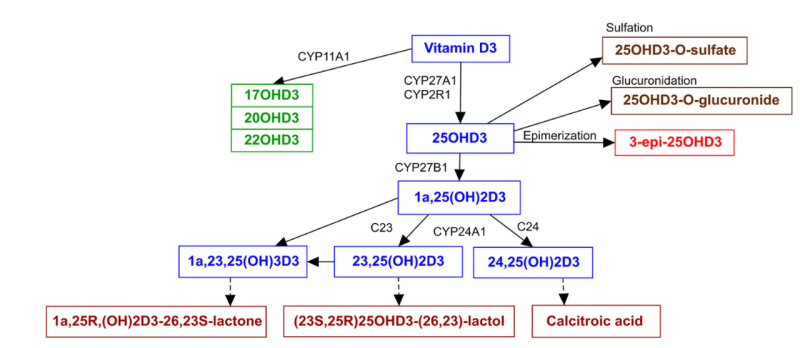
Figure 1: Phase I activation and inactivation metabolism pathways of vitamin D3 (Jenkinson 2019, Cell Biochem Funct.)
Vitamin D undergoes phase II metabolism which occurs by hepatic conjugation consisting predominantly of enzyme catalysed sulfation and glucuronidation. The principal process of conjugation is for the inactivation of bioactive metabolites, rendering them more hydrophilic, thereby facilitating their biliary or renal excretion. However, an additional mechanism for phase II metabolism has been recently reported for conjugated steroid hormone metabolites, specifically that sulfated steroids in the circulation act as storage forms and a reservoir for future hydrolysis back to their biologically active unconjugated forms. This mechanism has been further supported by the presence of the human steroid sulfatase (STS) enzyme in tissues for localised hydrolysis of sulfate conjugates. Our recent work has shown that four vitamin D metabolites, including 25OHD3 and 25OHD2 circulate in high abundance as phase II metabolites, particularly as sulfated conjugates. However, it still remains unclear whether the main biological function of vitamin D conjugation is for inactivation and excretion, or to retain in the circulation for future deconjugation. Our projects are aiming to understand this phase II metabolism profile further, including determining the role of these conjugate forms within the circulation and under different health and physiology environments.
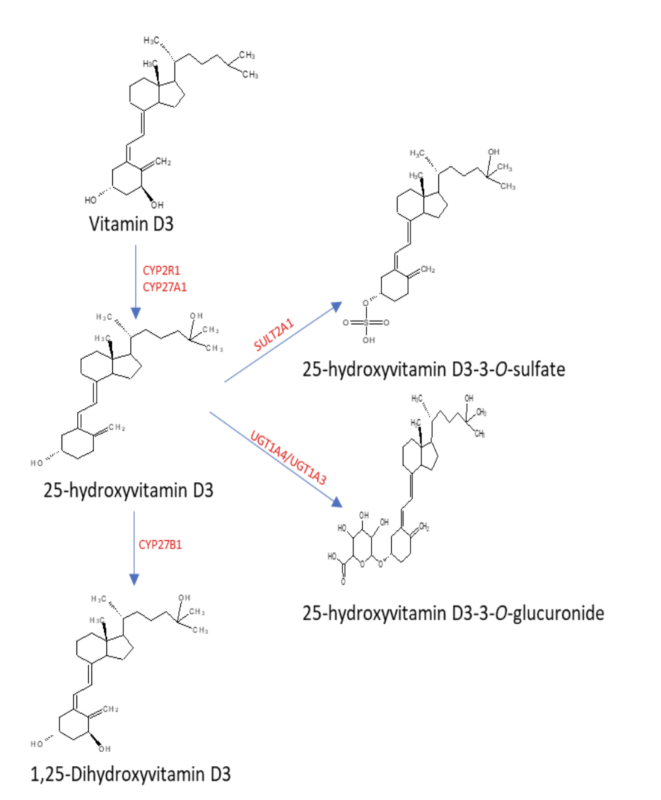
Figure 2: Phase II metabolism of 25-hydroxyvitamin D including the addition of a sulfate moeity by sulfotransferases (SULTs) enzymes, and the addition of a Uridine diphosphate glucuronic acid by Glucuronosyltransferase (UGT) enzymes (Huynh et al. 2021, Steroids.).
Vitamin D metabolism are transported bound to vitamin D binding protein with individual Gc isoforms influencing the bioavailability and distribution of metabolites throughout the body. We are aiming to assess how vitamin D binding protein measurements and isoform identification contribute to vitamin D metabolism through the development of bottom-up proteomics LC-MS/MS methods.
Localised vitamin D metabolism within tissues forms a key part of its physiological actions. To investigate vitamin D metabolism beyond the circulation we are aiming to use different mass spectrometry techniques to quantify metabolites within specific localised tissue sites. This approach will provide unique assessments into the biological functions of phase II vitamin D metabolites, and whether they undergo hydrolysis within tissues.
LC-MS/MS and sample method development
LC-MS/MS enables refined analysis of metabolic pathways including targeted accurate analysis of multiple metabolite measurements in a single sample run. Liquid chromatography achieves separation of compounds based on the structural elution from a chromatography column enabling separation of isoforms, while the MS/MS achieves a sensitive and selective analytical profile based on the mass to charge ratio of compounds. Accurate analysis of metabolites can be characterised by undertaking a thorough validation and assessment of analytical methods in accordance to accredited standards.
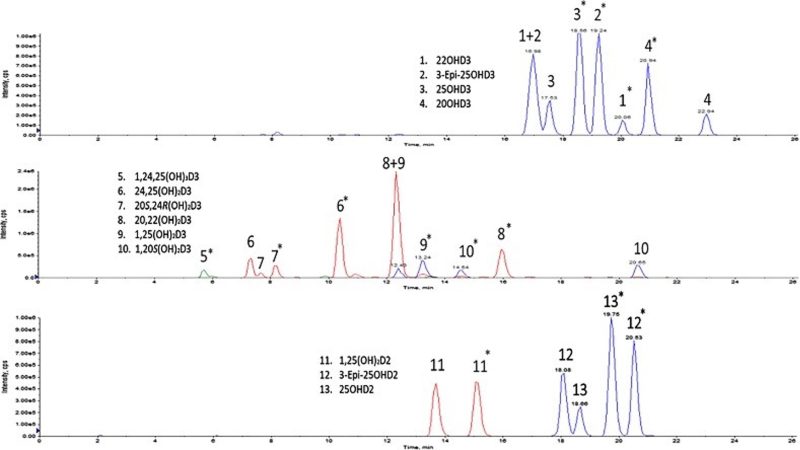
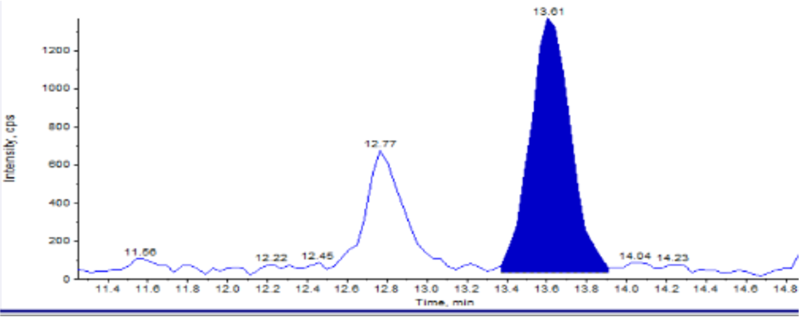
Figure 3: (a) LC-MS/MS chromatic separation of multiple mono-, di, and tri-hydroxyvitamin D3 and D3 metabolites following sample extraction. (b) LC-MS/MS measurement of 1,25(OH)2D3 at 12.5 pg/mL following chemical derivatization (Jenkinson et al. 2021, Clin Chem Lab Med.)
In addition to LC-MS/MS method development projects, a further objective within our analytical method development is to advance the throughput and automation of our sample preparation methods. We are aiming to automate sample extraction methods and increase throughput of analysis with the use of a Andrew+ and Extraction+ system.
Translational application of analysis
Our developed analytical methods will be applied to observation and clinical trial samples, as well as in vitro and in vivo models to achieve a comprehensive understanding of vitamin D physiology and the impacts of its deficiency and sufficiency on human health. This includes key population groups in which vitamin D physiology has significant contributions to health including pregnancy and skeletal health in ageing cohort groups. Other areas of interest include individuals with enzyme dysregulation or mutations that may impact the activation and inactivation of vitamin D, and potential health consequences through impaired metabolism pathways. Our in vitro and in vivo models explore enzyme activities and metabolism profiles as well as changed to vitamin D bioavailability following supplementation of vitamin D.
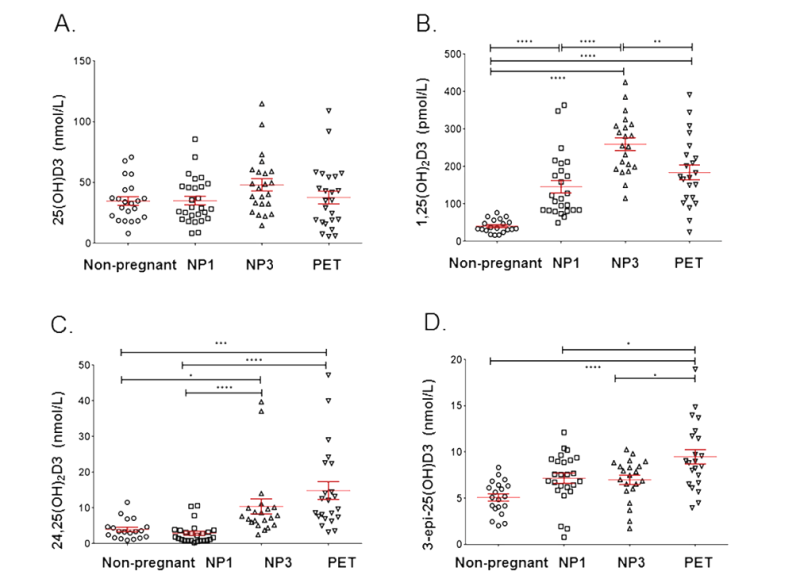
Figure 4: LC-MS/MS measurements of circulating vitamin D metabolites across pregnancy, and non-pregnant women (Tamblyn et al. 2016, Placenta.)
Our research aims to investigate the role of vitamin D metabolism on health outcomes using mass spectrometry as a translational application tool. Vitamin D has skeletal and extra-skeletal actions, and its deficiency can have wide ranging impacts across health.
Mass spectrometry enables refined analysis for the quantitation of metabolic pathways spanning synthesis, activation and inactivation. This approach can define the metabolism, transport, localised action and excretion of analytes through the measurements of different biological sample matrices.
Translational application of analytical methods across observational and clinical trial studies aim to characterise the role of vitamin D in health, including sex specific and ageing related health and disease. This includes defining optimal levels for population groups and addressing the impact of supplementation. A further objective is to establish more accurate approaches for defining vitamin D status through identification of novel biomarkers to generate clinical diagnostic methods.